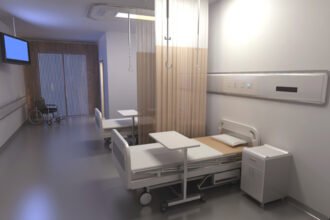 First published on MedCityNews.com. A new 30,000-square-foot incubator opening later this year in South San Francisco aims to make starting a life science company as quick and capital-efficient as starting a tech company.
First published on MedCityNews.com. A new 30,000-square-foot incubator opening later this year in South San Francisco aims to make starting a life science company as quick and capital-efficient as starting a tech company.
 First published on MedCityNews.com. A new 30,000-square-foot incubator opening later this year in South San Francisco aims to make starting a life science company as quick and capital-efficient as starting a tech company.
First published on MedCityNews.com. A new 30,000-square-foot incubator opening later this year in South San Francisco aims to make starting a life science company as quick and capital-efficient as starting a tech company.
The incubator, which will house up to 50 healthcare startups, is the newest offshoot of Janssen Labs, a component of Johnson & Johnson’s external R&D engine that runs no-strings-attached incubators in San Diego and Boston, too. In exchange for a monthly fee, startups get access to private and shared lab and office spaces as well as operational support, education and business services.
“The goal is to be able to have these companies get started within 24 hours without having to have investment dollars – in fact, they can start their company on a credit card if they need to – and to focus on the science,” said Melinda Richter, head of Janssen Labs.
I interviewed Richter last month, and she explained how the model was designed to move science forward, to improve the overall investment profile of the life science sector and to help Janssen’s pharmaceutical and biotech businesses grow their pipelines.
Janssen doesn’t take equity in any of the companies that take up residence in its incubator, nor does it guarantee them any kind of future deals with the company. But it does provide them early connections that may eventually lead to deals. Five of the 56 companies that have so far been part of the incubator have established further relationship with J&J/Janssen, including Assembly Pharma, which got an investment from Johnson & Johnson Development Corp. last month.
Meanwhile, other startups have partnered with different big pharma and biotech companies — a move both encouraged and applauded by Janssen Labs. Triphase Pharmaceuticals, for one, signed a deal with Celgene earlier this year around options for the cancer drugs it’s developing.
In our interview, Richter talked more in depth about how and why the no-strings-attached, open innovation model works.
If Janssen/J&J in most cases isn’t taking a financial or business interest in these companies, what kind of benefit does it see from Janssen Labs?
“There’s no shortage of need, and that’s why we believe that doing things for the industry, which is good for all of our competitors, is good. We’re not scared of that at all. In fact, we want the industry to get better; we want everyone to benefit from it because the need is so great and it’s growing every day. We don’t worry about having market. There’s plenty of market out there for everybody. What we need to do is make this industry a better investment profile for investors to put their money into it.”
So what’s the logic around which companies get in?
“We go through a selection process to determine which companies have the highest potential to meet an important unmet medical need. That need may be within our strategic areas of interest, or it may not. We can look at something that may be outside our current areas of interest, but we know because it’s so early stage it may end up in our strategic areas of interest. But we also look for companies that have great science behind them and rock star teams. Those teams can comprise experienced serial entrepreneurs, or they could be hot, dynamic new talent with a passion for something revolutionary. We want to support that mixed community.”
As Janssen Labs expands, will it continue to evolve?
“We’re looking at physically, where are the right regions to be in and how should we show up there. We’re also looking at expanding our sectors. We cross all sectors, from consumers to medical device diagnostics to therapeutics. We also have healthcare IT, so we’re looking at how do we get into the tech space in the life sciences in a bigger way. And we’re also looking at how we can add more solutions for the companies. In that regard, we don’t consider our model static at all. You will continue to see this model become something more integrated with the companies but also integrated within Johnson & Johnson.”





